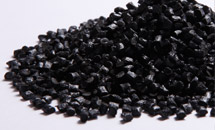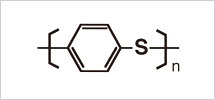What are PPS Compounds?
Polyphenylene sulfide (PPS) resin is a crystalline heat resistant polymer that has a simple chemical structure made from benzene and sulfur. This resin possess high heat resistance with a melting point of approximately 280°C and excellent chemical resistance, along with self-extinguishing without adding flame retardants.
Polyphenylene sulfide (PPS) is a partially crystalline, high temperature performance polymer that has the chemical structure shown in the figure on the right. This polymer has a high melting point of approximately 280°C, excellent chemical resistance and is inherently flame retardant. It possesses self-extinguishing properties without the addition of any flame retardant chemical additives.
DIC.PPS, an engineering compound formulated with both glass fiber and/or mineral filler, features the characteristics of a typical engineering thermoplastic. However, it also exhibits superior elevated temperature resistance, advanced mechanical properties and excellent dimensional stability designed to meet demanding tight tolerance applications.
DIC.PPS is broadly classified into two families of polymer – chemically branched and linear polymer. The branched PPS polymer exhibits high rigidity under elevated temperature conditions. This type delivers unique benefits associated with resistance to creep deformation. The other type is based on a linear PPS polymer and has the desirable features associated with tensile elongation and impact resistance. Because the linear polymer exhibits high purity, it is less prone to absorbing moisture under high heat and humidity conditions compared to the cross-linked polymer.
As a result, DIC.PPS product portfolio contains a wide variety of engineered products that can be custom formulated to meet the most demanding performance requirements. Versus traditional materials, such as steel or thermoset polymers, DIC.PPS products have the engineering features required to benefit component designers, tool designers and polymer process specialists which are seeking a truly engineered product.
■ Heat resistance that makes continuous usage possible at 200°C or higher
■ Maintains strength and high rigidity over wide temperature ranges
■ PPS polymer is inherently UL V-0 (self-extinguishing)
■ Excellent dimensional stability under most environmental conditions
■ Chemical resistance second only to fluorinated polymers (PTFE)
■ Advanced electrical properties under high heat, high humidity, high frequencies
■ Very complex, high precision molding is achievable
■ Very low moisture absorption
■ Recyclability (meets Green Initiative versus traditional materials)
PPS may be polymerized by the polycondensation reaction of para-dichlorobenzene (p-DCB) and sodium sulfide (Na2S) or sodium hydro sulfide (NaSH) in a polar solvent under elevated temperature and pressure conditions.
PPS is created by combining various elements - including a dehydration reaction, sodium chloride removal reaction, exothermic reaction, and high temperature pressurization reaction. An overview is shown below.
The polymer in the above polymerization reaction is processed as a molding compound after going through a refining process and thermal cross-linking treatment – which results in branched PPS).
PPS (polyphenylene sulfide) has an interesting history. Its existence was first brought to light by Friedel and Crafts in 1888. At the end of the 1940s, it was decided that PPS could become an engineering polymer with commercial importance.
Later, Phillips Petroleum (USA) developed a commercial process for polymerizing PPS and were the first to succeed at establishing a manufacturing operation in 1973. This early version of PPS had a relatively low molecular weight and applications were developed for its use in specialty coatings. Meanwhile, by increasing the molecular weight by a thermal cross-linking reaction in the presence of oxygen, both processing and mechanical properties were improved. It was also discovered that PPS would be suitable for injection molding and exhibit excellent heat and chemical resistance. As a result, demand for this new polymer continued to grow for more advanced engineering component applications.
DIC imported the neat PPS polymer from Phillips Petroleum and drove the introduction of this polymer as a molding compound by also incorporating reinforcing glass fiber and mineral fillers to target various market applications.
After Phillips Petroleum's basic process patent expired in November of 1984, additional companies, including DIC, initiated the introduction of their own brands of PPS compounded products. As the capacity for producing increasing levels of PPS polymer continued to grow in Japan, this led to intense product competition. As a result, DIC decided to focus on developing more advanced PPS product formulations to target the most demanding market applications.
DIC is currently developing straight chain and high molecular weight branched polymers by increasing the molecular weight at the polymerization reaction stage. Branched PPS products exhibiting high impact properties, as well as development of grades with improved processing features such as reduced flashing and decreased volatiles, were successfully developed as a result of advanced polymerization and compounding technologies. The majority of DIC.PPS polymer products are designed to be injection molded and their target market segments are automotive, electrical/electronics and aerospace.
Inquiry About This Product
-
Inquiry on website
-








